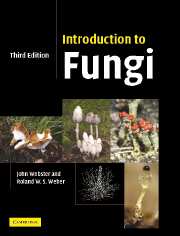Book contents
- Frontmatter
- Contents
- Preface to the first edition
- Preface to the second edition
- Preface to the third edition
- Acknowledgements
- 1 Introduction
- 2 Protozoa: Myxomycota (slime moulds)
- 3 Protozoa: Plasmodiophoromycota
- 4 Straminipila: minor fungal phyla
- 5 Straminipila: Oomycota
- 6 Chytridiomycota
- 7 Zygomycota
- 8 Ascomycota (ascomycetes)
- 9 Archiascomycetes
- 10 Hemiascomycetes
- 11 Plectomycetes
- 12 Hymenoascomycetes: Pyrenomycetes
- 13 Hymenoascomycetes: Erysiphales
- 14 Hymenoascomycetes: Pezizales (operculate discomycetes)
- 15 Hymenoascomycetes: Helotiales (inoperculate discomycetes)
- 16 Lichenized fungi (chiefly Hymenoascomycetes: Lecanorales)
- 17 Loculoascomycetes
- 18 Basidiomycota
- 19 Homobasidiomycetes
- 20 Homobasidiomycetes: gasteromycetes
- 21 Heterobasidiomycetes
- 22 Urediniomycetes: Uredinales (rust fungi)
- 23 Ustilaginomycetes: smut fungi and their allies
- 24 Basidiomycete yeasts
- 25 Anamorphic fungi (nematophagous and aquatic forms)
- References
- Index
- Plate section
8 - Ascomycota (ascomycetes)
- Frontmatter
- Contents
- Preface to the first edition
- Preface to the second edition
- Preface to the third edition
- Acknowledgements
- 1 Introduction
- 2 Protozoa: Myxomycota (slime moulds)
- 3 Protozoa: Plasmodiophoromycota
- 4 Straminipila: minor fungal phyla
- 5 Straminipila: Oomycota
- 6 Chytridiomycota
- 7 Zygomycota
- 8 Ascomycota (ascomycetes)
- 9 Archiascomycetes
- 10 Hemiascomycetes
- 11 Plectomycetes
- 12 Hymenoascomycetes: Pyrenomycetes
- 13 Hymenoascomycetes: Erysiphales
- 14 Hymenoascomycetes: Pezizales (operculate discomycetes)
- 15 Hymenoascomycetes: Helotiales (inoperculate discomycetes)
- 16 Lichenized fungi (chiefly Hymenoascomycetes: Lecanorales)
- 17 Loculoascomycetes
- 18 Basidiomycota
- 19 Homobasidiomycetes
- 20 Homobasidiomycetes: gasteromycetes
- 21 Heterobasidiomycetes
- 22 Urediniomycetes: Uredinales (rust fungi)
- 23 Ustilaginomycetes: smut fungi and their allies
- 24 Basidiomycete yeasts
- 25 Anamorphic fungi (nematophagous and aquatic forms)
- References
- Index
- Plate section
Summary
Introduction
The phylum Ascomycota (colloquially called ascomycetes) is by far the largest group of fungi, estimated to include more than 32 000 described species in 3400 genera (Kirk et al., 2001). It is assumed that the majority of ascomycetes has yet to be discovered, and the total number of species may well be higher by a factor of 10–20 or even more (see Hawksworth, 2001). The name is derived from the Greek words askos (a leather bottle, bag or bladder) and mykes (a fungus), so ascomycetes are sac fungi. The characteristic feature of the group is that the sexually produced spores, the ascospores (see p. 25), are contained within a sac, the ascus. In most ascomycetes the ascus contains eight ascospores and is turgid, ejecting its spores by a squirt mechanism.
There is a very wide range of lifestyles. Some ascomycetes are saprotrophs, others necrotrophic or biotrophic parasites of plants and animals, including humans. Examples of biotrophic parasites are the Erysiphales, the cause of many powdery mildew diseases of plants (Chapter 13), the Taphrinales (p. 251) causing a range of plant diseases associated with growth abnormalities, and the Laboulbeniales, relatively harmless ectoparasites of beetles and some other insects (Blackwell, 1994; Weir & Blackwell, 2001). Many ascomycetes grow as endophytes in symptomless associations with plants. Some are mutualistic symbionts, for example the lichens (Chapter 13) which make up about 40% of the described species of ascomycetes.
- Type
- Chapter
- Information
- Introduction to Fungi , pp. 226 - 249Publisher: Cambridge University PressPrint publication year: 2007



